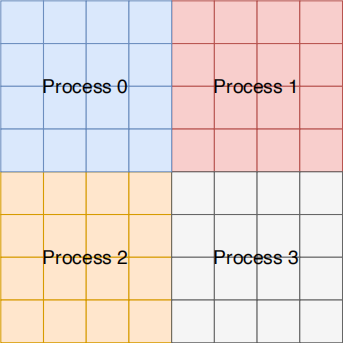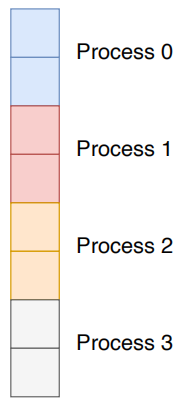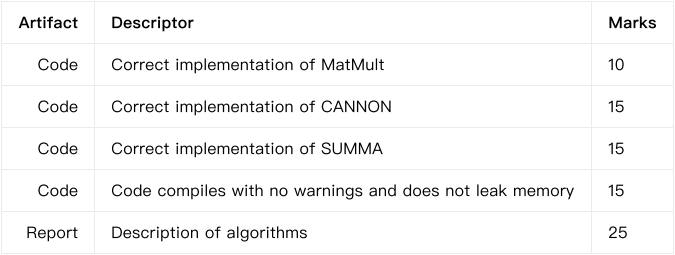Coursework: parallel dense linear algebra
Dense linear algebra in parallel
You should submit your work for this coursework via DUO. The submission deadline is 2021/01/11 at 14:00UTC.
Updates 2020/12/11
Added link to descriptors for written work in mark scheme.Updates 2020/12/08
The notation

means that the floor of the division (i.e. rounding down to the nearest integer) should be equal to the original division. That is N should be divisible by p with no remainder.
Changed instances of mpiexec in the examples to mpirun for consistency with the rest of the notes.
In this coursework you are to write parallel implementations of some dense linear algebra operations using MPI, and benchmark the scaling performance. You should not use other forms of parallelism.
I provide template code that contains input/output routines and skeleton data structures. There are a number of functions that you need to provide an implementation for.
You will implement a (simplified) case of a small number of the parallel BLAS routines using MPI.
In particular, you should implement the matrix-vector product
and two algorithms for the matrix-matrix product
For square matrices A, B, C ∈ RN×N and vectors x, y ∈ RN.
Data layout
To simplify things, the setup is restricted to square matrices, that are distributed using a 2D block layout, where each process stores a contiguous block of the matrix.
This is shown below for a 8 × 8 matrix and four processes.

The process grid must evenly divide the matrix rows and columns, so every local piece is the same size. That is, we require, for p processes and an N × N matrix that

and

This ensures that all processes have the same local matrix size, which simplifies some implementation.
Furthermore, for matrix-vector products, we also require that

On each process, the local part of the matrix is stored in row major format.
Row major indexing
Vectors are distributed by allocating a contiguous chunk of entries to each process. Again, the number of process much evenly divide the number entries in the vector
This is shown below for an 8-element vector and four processes.

Blocked data distribution of a vector over four processes.
Skeleton code
I provide a skeleton code in C which provides datatypes for vectors and matrices, some viewing facilities (for debugging), and has various options for benchmarking performance and testing correctnessDownload it as a tarball here, or else find the code in the /code/coursework subdirectory of the course repository.
You should do your implementation in the solution.c file, which contains three functions that you need to implement. They are correct when run in serial, but do not yet work correctly in parallel.
Required modules
Building on Hamilton or COSMA needs a few modules. On your own system you may need to edit the Makefile .

Having set up the environment by loading the required modules, build the code with make and run the executable with ./main , with no arguments, it reports usage information.
$ cd coursework
$ make
$ ./main
Matrix size is a required argument please specify with -N.
Usage:
./main -N N [-a ALGORITHM] [-t MODE] [-f FILE] [-h]
Run benchmarking or checking of matrix-vector or matrix-matrix multiplication
Options:
-N N
Set matrix size (required).
-a CANNON | SUMMA
Select algorithm for matrix-matrix multiplication (default SUMMA).
-t CHECK_MAT_MULT | BENCH_MAT_MULT | CHECK_MAT_MAT_MULT | BENCH_MAT_MAT_MULT Select execution mode (default CHECK_MAT_MAT_MULT).
CHECK_MAT_MULT: check correctness of matrix-vector multiplication.
BENCH_MAT_MULT: print timing data for matrix-vector multiplication.
CHECK_MAT_MAT_MULT: check correctness of matrix-matrix multiplication.
BENCH_MAT_MAT_MULT: print timing data for matrix-matrix multiplication.
-f FILE
In benchmarking mode, print timing data to FILE in JSON format.
WARNING: overwrites output file if it exists.
Use "-f -" to dump to standard output.
-h
Print this help.
The executable has a checking mode, which checks that the implementations of matrix- vector and matrix-matrix multiplication are correct. Only the serial multiplication is implemented, so it only reports a passed test when running with one process. It also prints a warning that nothing is implemented yet.
$ mpirun -n 1 ./main -t CHECK_MAT_MULT -N 8
[MatMult]: TODO, please implement me.
CheckMatMult succeeded.
$ mpirun -n 4 ./main -t CHECK_MAT_MULT -N 8
[MatMult]: TODO, please implement me.
[1] CheckMatMult failed at local index 0, expected 26 got 12
[1] CheckMatMult failed at local index 1, expected 26 got 12
[MatMult]: TODO, please implement me.
[2] CheckMatMult failed at local index 0, expected 66 got 12
[2] CheckMatMult failed at local index 1, expected 66 got 12
[MatMult]: TODO, please implement me.
[3] CheckMatMult failed at local index 0, expected 66 got 8
[3] CheckMatMult failed at local index 1, expected 66 got 8
[MatMult]: TODO, please implement me.
[0] CheckMatMult failed at local index 0, expected 26 got 8
[0] CheckMatMult failed at local index 1, expected 26 got 8
CheckMatMult failed.
Now we see an error and reports of where a mismatch was observed.
In benchmark mode, the matrices and vectors are filled with random numbers and then the relevant operation is performed. On successful completion of the benchmark, the program prints a short summary of the performance. It can also dump in machine- readable json format to a specified file with -f data.json .
When writing to a file, any existing contents are overwritten!
You can load json files in Python with something like
import json
with open("data.json", "r") as f:
data = json.load(f)
For example
$ ./main -t BENCH_MAT_MAT_MULT -a CANNON -N 1000
[MatMatMultCannon]: TODO, please implement me.
Timing data for MatMatMult[CANNON] on 1 processes, matrix size 1000
All data in seconds. Min, Mean, Max, Standard deviation.
0.0186729 0.0186729 0.0186729 0
Code details
The data types are defined in mat.h and vec.h for the Mat and Vec types respectively.
The Mat data type is a pointer to a struct
struct _p_Mat {
MPI_Comm comm; /* communicator */
int n, N; /* local and global size */
int np; /* process grid np x np */
double *data; /* matrix entries in row-major format */
};
So if you have a Mat A , its local size is A->n .
Similarly, the Vec data type is a pointer to a struct
struct _p_Vec {
MPI_Comm comm; /* communicator */
int n, N; /* local and global size */
int np; /* number of processes */
double *data; /* vector entries */
};
All routines return an error code ( return 0 for no error) can be checked with the CHKERR macro as shown in the template code.
For debugging purposes, I provide routines
int MatView(Mat A, FILE *output);
int VecView(Vec x, FILE *output);
which can be used to print the provided matrix or vector. You can pass NULL to print to standard output.
Task
You should implement matrix-vector multiplication, and two algorithms for parallel matrix-matrix multiplication in parallel. You should use MPI for parallelisation.
Having checked the correctness of your implementation, you should perform a weak and strong scaling study of the three routines. Up to around 256 processes on Hamilton (or COSMA).
Finally, you should write a short (maximum four pages) report describing the algorithms as you implemented them and any choices you made, and discussing your findings from the scaling study.
Matrix-vector multiplication
For this routine, you are free to choose your own algorithm (which you should describe in the report). You should aim for an approach which is memory scalable, in the sense that the amount of memory needed by each process is related to N/P rather than N (for an N × N matrix on P processes).
Matrix-matrix multiplication
For this routine, you should implement two approaches (which you should describe in the report):
1. Cannon’s algorithm, which is described nicely by Jim Demmel.
2. SUMMA, which is a more general method (although we do not implement the full generality here). David Bindel has a nice description in these slides [pages 2-8].
Since we are restricting ourselves to a square grid of processes, the data transfer steps can always operate on the full local matrix (rather than the extra blocking as described in the SUMMA paper).
Mark scheme and submission
You should submit, via DUO, a PDF of your report (max 4 pages), and a zip-file of your implementation ( solution.c ).
I will build and test your code using the coursework skeleton code, so you should make sure that your code compiles and runs correctly with an unmodified version of the skeleton.


The report will be marked with reference to the descriptors for written work (non- dissertation) found on DUO, see MSc in Scientific Computing and Data Analysis Programme → Assessments and Procedures → Marking criteria for written work (non- dissertation).
You can check memory leaks with Valgrind. I provide some instructions below.
Hints
I find it very helpful to draw things out for a small matrix and small number of processes. Then I can see what is going on, and figure out how to generalise things.
For debugging purposes, feel free to add printf and other statements to your code, but your final submission should not contain any printf output.
Using valgrind for memory correctness
Valgrind is an excellent memory debugger. On Hamilton, you can use it like this:
module load valgrind
You then run your program with
$ valgrind --leak-check=full ./main ANY ARGUMENTS HERE
When running in parallel you should run one valgrind process per MPI task. In that case, it is useful to send the output to a log file per process.
$ mpirun -n 4 valgrind --log-file="log-file.%p" --leak-check=full ./main ANY
Unfortunately, the Intel MPI library on Hamilton has a number of memory leaks. I therefore recommend the following recipe for checking memory leaks. This is what I will do to check things.
DO NOT use the MPICH module for any performance testing, since it does not use the high-speed interconnect!
$ module load intel/2019.5
$ module load mpich2
$ module load valgrind
$ module load gcc/8.2.0
$ module load openblas
$ make clean
$ make all
$ mpirun -n 4 valgrind --log-file="valgrind-log.%p" --leak-check=full --suppr
Where the file valgrind.supp is included in the coursework tarball
A successful run will look something like
$ mpirun -n 1 valgrind --leak-check=full --suppressions=valgrind.supp ./main
==28983== Memcheck, a memory error detector
==28983== Copyright (C) 2002-2017, and GNU GPL'd, by Julian Seward et al.
==28983== Using Valgrind-3.14.0 and LibVEX; rerun with -h for copyright info
==28983== Command: ./main -t CHECK_MAT_MULT -N 8
==28983==
CheckMatMult succeeded.
==28983==
==28983== HEAP SUMMARY:
==28983== in use at exit: 0 bytes in 0 blocks
==28983== total heap usage: 241 allocs, 241 frees, 4,310,004 bytes allocate
==28983==
==28983== All heap blocks were freed -- no leaks are possible
==28983==
==28983== For counts of detected and suppressed errors, rerun with: -v
==28983== ERROR SUMMARY: 0 errors from 0 contexts (suppressed: 2 from 2)
Whereas if we failed to deallocate some memory, we see something like
==30038== Memcheck, a memory error detector
==30038== Copyright (C) 2002-2017, and GNU GPL'd, by Julian Seward et al.
==30038== Using Valgrind-3.14.0 and LibVEX; rerun with -h for copyright info
==30038== Command: ./main -t CHECK_MAT_MULT -N 8
==30038==
CheckMatMult succeeded.
==30038==
==30038== HEAP SUMMARY:
==30038== in use at exit: 64 bytes in 1 blocks
==30038== total heap usage: 241 allocs, 240 frees, 4,310,004 bytes allocate
==30038==
==30038== 64 bytes in 1 blocks are definitely lost in loss record 1 of 1
==30038== at 0x4C29E83: malloc (vg_replace_malloc.c:299)
==30038== by 0x406474: MatMult (solution.c:23)
==30038== by 0x404F88: CheckMatMult (check.c:24)
==30038== by 0x403AF9: main (main.c:148)
==30038==
==30038== LEAK SUMMARY:
==30038== definitely lost: 64 bytes in 1 blocks
==30038== indirectly lost: 0 bytes in 0 blocks
==30038== possibly lost: 0 bytes in 0 blocks
==30038== still reachable: 0 bytes in 0 blocks
==30038== suppressed: 0 bytes in 0 blocks
==30038==
==30038== For counts of detected and suppressed errors, rerun with: -v
==30038== ERROR SUMMARY: 1 errors from 1 contexts (suppressed: 2 from 2)
This tells us that memory allocated on line 23 of solution.c was never free d.